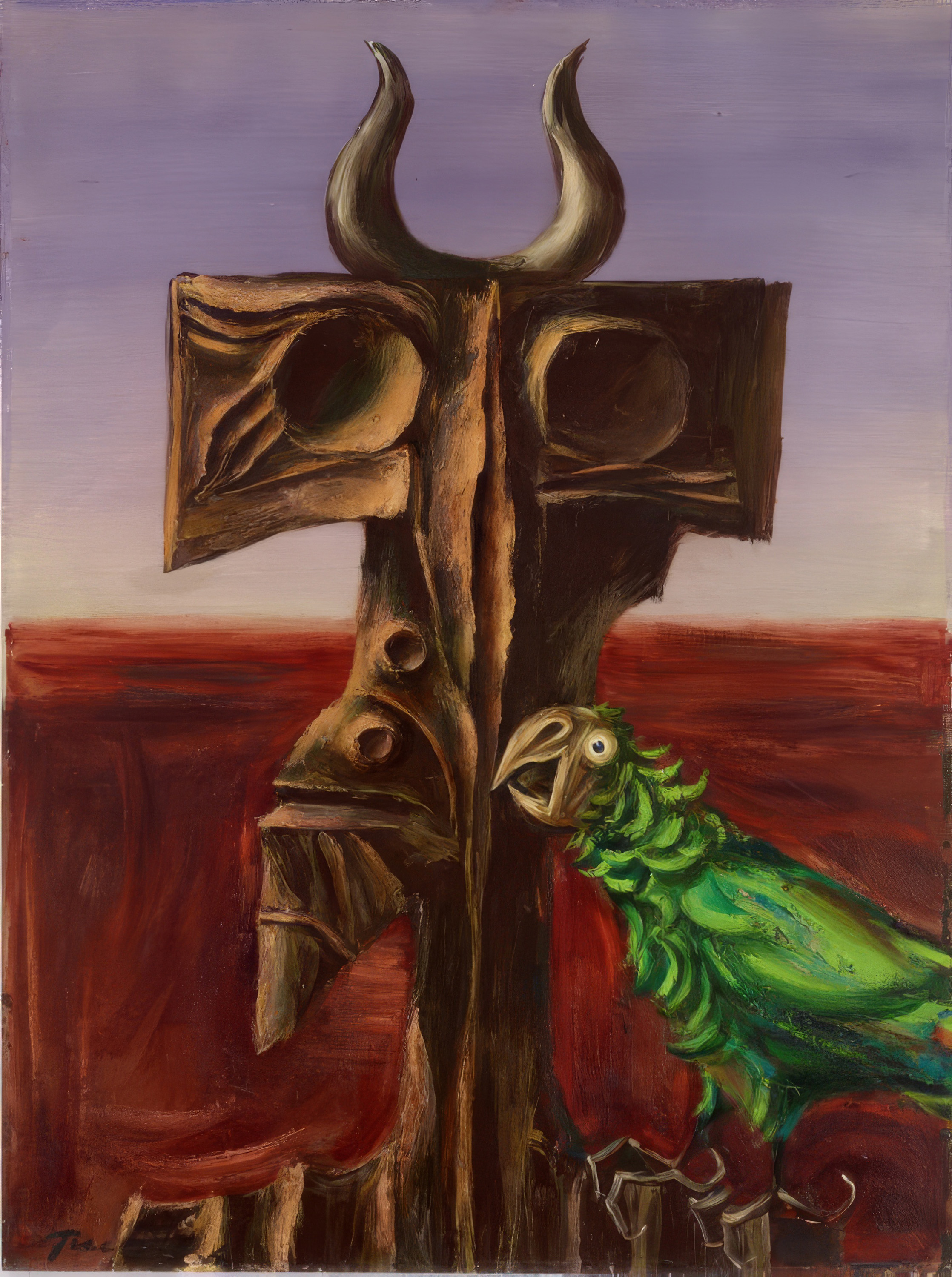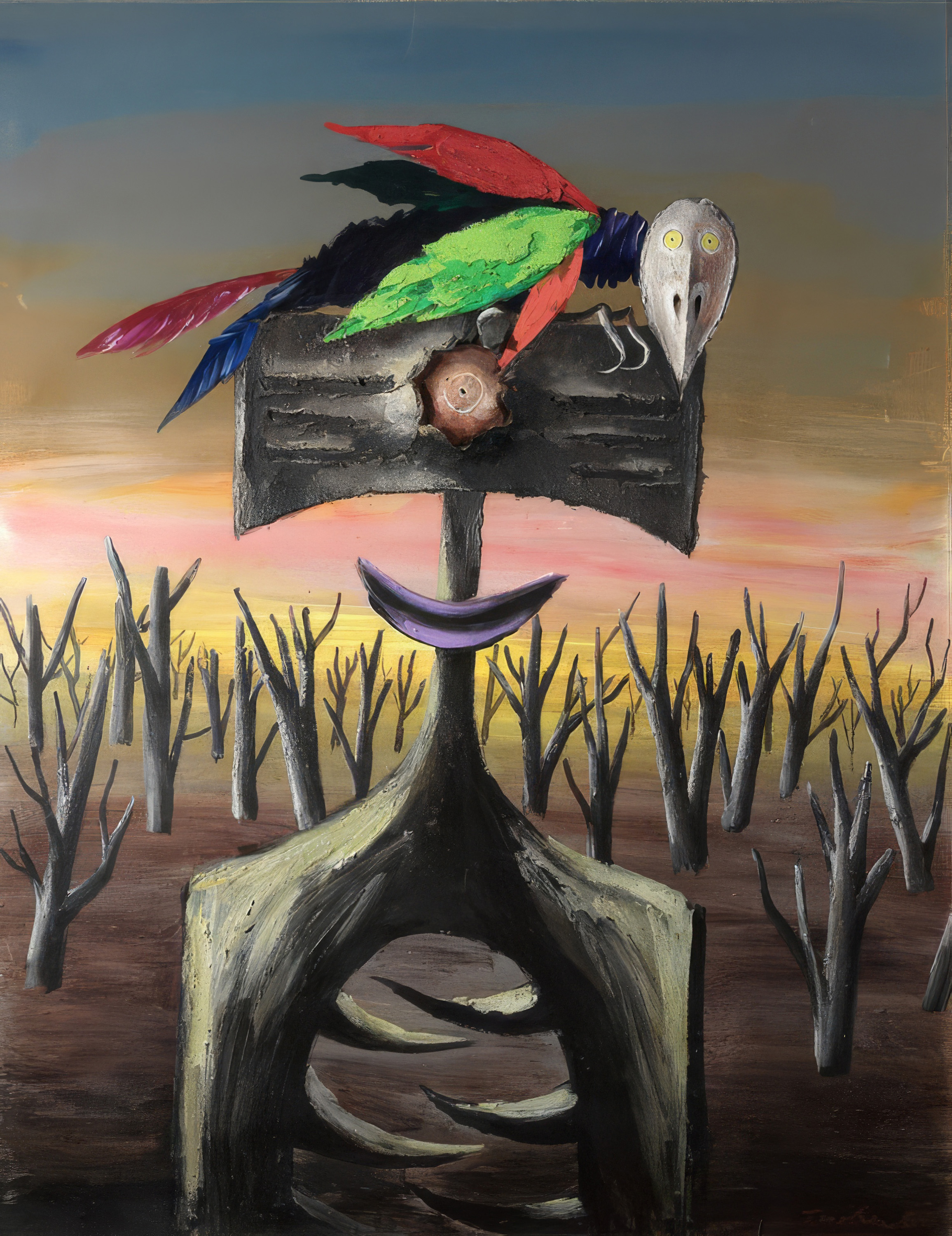HORNED FIGURE, 1966
ALBERT TUCKER
synthetic polymer paint on composition board
91.0 x 122.0 cm
signed and dated lower left: Tucker / 1966
inscribed with title verso: HORNED FIGURE
bears inscription on gallery label verso: HORNED FIGURE / ALBERT TUCKER
Australian Galleries, Melbourne (label attached verso)
Private collection, Melbourne
Albert Tucker, Australian Galleries, Melbourne, 26 April – 13 May 1966, cat. 15
250024 Tucker-(cleaned).jpg

Albert Tucker decided to explore distinctly Australian themes in his work while living in Italy (he had left Australia in 1947 and was to not return until 1960), where distance allowed a different perspective on the creative possibilities contained within inherited myths and traditions. Sharing a fascination with the story of Ned Kelly alongside his close friend Sidney Nolan, who had painted his first Kelly series in 1946 – 47, Tucker began his investigations of Australian iconography in the same place, creating versions of the Kelly story that pictured the bushranger as a dark, mysterious and isolated figure quite unlike the jaunty iron-clad hero of Nolan’s brightly coloured Ripolin paintings. As Tucker later recalled in an interview with Janet Hawley, he had once said to Nolan that ‘I was painting hell, and he was painting paradise… and I saw a very satisfied grin spread across Nolan’s face.’1
The subject of Kelly was a starting point for Tucker, resulting in a broader exploration of the hardship of life in the Australian bush and the relationship between man and the land. The craggy and scarified forms of Tucker’s images from this time – thick with paint and encrusted surfaces – were no doubt inspired in part by Nolan’s photographs of the 1962 Queensland drought, which he shared with Tucker when the pair reconnected in Rome where Tucker was based.2 However, the artist’s discovery in Paris of the work of Jean Dubuffet, and his meeting with Italian artist Alberto Burri while living in Rome, also played a considerable role in this important transition in his practice. Tucker soon adopted Burri’s use of polyvinyl acetate (which enabled Burri to build up the surfaces of his works), using its ‘flexible and leathery toughness’3 to great effect in his subsequent Antipodean Heads, and, as these works coalesced into bushrangers, explorers and other creatures, for the remainer of his career. As he recalled: ‘I’d been away long enough to be suffering acute bouts of nostalgia and I was getting all these memory images of Australia – and oddly enough not so much specific imagery, but in images of texture and colour and light and all that kind of thing that’s very Australian, very rough textures.’4
250024 Tucker (2)-(cleaned).jpg

Following the influence of artists such as Picasso, Tucker had a lifelong interest in non-Western art and he began collecting sculptures and masks in Melbourne in the 1940s, later travelling to New Guinea to experience the Sepik River region firsthand and further expand his collection. Like the early French modernists, ‘primitive’ art served as a liberating force in Tucker’s practice, helping to free him from the inherited constraints of the Western tradition and open his practice to the power and possibilities of myth. The potent combination of Surrealism, the poetry of T.S. Eliot and contemporary discussion of Jung’s archetypes, served as a platform for discovery and experimentation in his work from as early as the 1940s and the creation of his now iconic series Images of Modern Evil, 1943 – 48. From the grinning faces of the women in a painting such as Victory girls, 1943 (National Gallery of Australia) and the triangular gaping mouth of the figure in Memory of Leonski, 1943 (National Gallery of Victoria), the mouth motif thus transformed into the shape of a crescent, serving as a kind of visual shorthand for the artist:
‘In a way, that crescent thing became a kind of key; it was a hieroglyphic thing. I reached the point in around 1943 that, if I painted and I did not have that crescent, then I could not work. I would have to tear it down, throw it away, nothing would happen. But the moment I got that crescent image in, the thing would fill itself in. It was like automatic writing. Once I had that key form, the rest of the thing would fill itself in rapidly and immediately with whatever data was in my head at the time from wandering around Melbourne.’5
While maintaining an echo of Tucker’s crescent form, Horned figure, 1966 seemingly takes its cue from the mythological horned figures that populate ancient sculpture and the memory of a double-headed axe that the artist had seen in the Etruscan Museum in Rome.6 With its feathery visage and cleaved mouth, statuesque body and claw-like torso, the creature of Horned figure is a menacing and primordial amalgam of recognisable parts. And, like its creator’s contested relationship to his homeland, it appears at once part of the landscape it finds itself in, and strangely isolated from it. As Tucker reflected in later life:
‘…But I do feel that whatever the struggles and conflicts and difficulties of my own life and I did work out the resolution of a lot of them through images and painting and I’d hope this [his paintings] plots a sort of an autobiographical diagram almost, a diagrammatical account of my life because I think it can be traced through all that now. And so... I feel that I have left a few footprints shall I say…’7
1. Hawley, J., ‘Making Pictorial Sense of Modern Evil’, Good Weekend, 18 February 1995, p. 40, cited in Burke, J., Australian Gothic: A Life of Albert Tucker, Random House Australia, Sydney, 2002, p. 163
2. ‘Albert Tucker’, Art Gallery of New South Wales at: https://www.artgallery.nsw.gov.au/collection/artists/tucker-albert/ (accessed 23 March 2025)
3. ibid.
4. Harding, L., Hinterlands: Albert Tucker’s Landscapes 1960 – 75, Heide Museum of Modern Art, Bulleen, 2008, p. 31
5. ‘James Gleeson Interviews: Albert Tucker’ (transcript), 2 May 1979, National Gallery of Australia, at: https://nga.gov.au/media/dd/documents/tucker.pdf (accessed 23 May 2025)
6. ‘Albert Tucker, The Intruder, 1964’, Art Gallery of New South Wales, at: https://www.artgallery.nsw.gov.au/collection/works/429.2016/#about (accessed 23 May 2025)
7. Heimans, F., Australian Biography: Albert Tucker, (video excerpt and transcript), 26 mins, 1993, National Film and Sound Archive, at: https://www.nfsa.gov.au/collection/curated/asset/99512-australian-biogra... (accessed 23 May 2025)
KELLY GELLATLY


